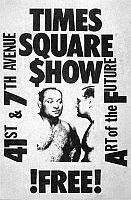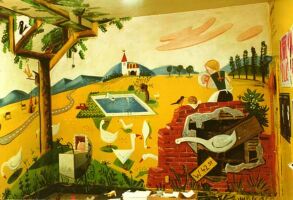|
Normal Group – exhibitions
1979
Bonn
(advertising board) /Galerie
Magers/
Düsseldorf /Fussgängerzone/
1980
Normal.
Galerie H. J. Müller, Köln
Normal. Times Square Show, New York
Normal. Galerie Defet, Nürnberg
XI Biennale de Paris. Musée d´Art Modern
1981
Rundschau Deutschland.
Lothringerstr. 13, München
Aljofre Barroco. Salone di Palazzo Ducezio/Noto (Italy)
Normal. Museo Civico d´Arte Contemporanea,
Gibellina
Bildwechsel. Akademie der Künste, Berlin
Normal.
Neue Galerie und Sammlung Ludwig, Aachen
1982
Normal. Galerie Nörballe,
Kopenhagen
Normal
und Freunde.
Galerie Beck im Frauenmuseum, Bonn
1984
Von
hier aus. Neue deutsche Kunst. Messegelände Halle 13, Düsseldorf
(skupina /gruppo/ Normal)
1986
Gruppe Normal. Graphikmappe des Griffelkunstverlags, Hamburg
2005
Normal Group. Prague Biennale 2, Karlín Hall, Praha
2006
Group Normal. Flash Art Museum, Trevi
Group Normal. Museo d´Arte Contemporanea, Isernia
2025
Gruppe Normal – Die anderen‚ Jungen Wilden‘. Grisebach GmbH, Berlin
(26. 3.–4. 5.)
|
Text z katalogu
Normal / Catalogue Normal Group
Museo Civico di Gibellana, Italy 1981
Demetrio Paparoni
In the Circus of the Metropolis
The loss of sense: a way
of life has been consumed, the modern way which presupposes faith in
ideology; communication - the communication system - has been
parallely renewed. Related to an aimless reality which has put the
hope of emancipation at zero, language has discovered itself to be
deprived of its old role as a vehicle of information. Man today - as
Lyotard affirms - no longer believes that in a marxist system all will
be well in the end; in the same way the thesis that in a capitalist
society everyone will get rich is no longer credible. Such awareness
has not stopped any clock nor could it ever have done so, but the
becoming in time has stopped being optimistic as it was for modern man
who, moving inside a mentality culturally connotated as avant-guard
lived on hopes of progress.
It was thought that, interrogating itself on
its own specific, language "spoke", that it gave, that is,
new acquisitions. And so undoubtedly was the case, but in the end such
awareness showed itself to be progressively demotivated by the loss of
ideology: as if philosophical language had found itself without points
to explain and the meaning of words and images consequently thinned
down to become transparent.
Moving beyond the experiences of the
modernist problematic, contemporary culture has enstaged an operative
impartiality which is dance momentarily tendent towards liberation,
speed of mind that consumes without seeing any problems, remembrances
rendered a funrtion of the play of expressive liberty: we have gone
from an aesthetic composed of fragments to an aesthetic of the
fragment inside mental dimensions characterized by the loss of
ideological moralisms. All is allowed - paradoxically, even the making
of fragments of a nearer past become "relevant
again"-because culture haunts a no man's land belonging to all, a
place deprived of the magnetism of erudite allusions.
The intuition has not been to
recuperate, if only in an instrumental manner, fragments of the past;
it has been, if at all, a necessity as much as to succeed in utilizing
a language that, freezing the functions of reference points, has taken
away our keys to the reading of a work.
|
Also in the works of Peter Angermann,
Milan Kunc, John Hummel and Jan Knap the images are singularly
recognizable but their succession and accumulation give evanescent
wholes. The painting is the ftame delimiting ftagments which fit
together like pieces ftom different jigsaw puzzles and live in the new
context shorn of their original meanings, the negation of the primal
common sense.
A painting released from the
ideological yoke cannot but be foreign to a concept that makes art a
journey conditioned by the fidelity to a project. So, the painting of
the Normal Group is narrative and each work exhaustively describes a
different subject experienced as a further possibility of
communication. The thread that holds the works of Angermann, Kunc,
Hummel and Knap together and that makes Normal a group for all intents
and purposes seems to be identifiable in that these artists do not
create information, they inform us, that is, of things that we
already know: navigating the performable of their own existere
they furnish expressions for use and communication. And
it is in the difference between performability and information that
lies the sense of the authentic open interpretation of their work. Our
attention is drawn towards known elements, come to us from a window
opened on purpose: everyday things consumed and experienced and still
generalizable. The painting does not speak words to be listened to but
if looked at in the eyes allows itself to be perceived. A language
reemerges in which the high (quality of painting) and the low (the
banality of the everyday) are inscribed in a dynamic relationship of
interchange which is no longer dialectic.
The Normal Group paints what it sees: a
love story or a sports story, an ecological tragedy or a war joke. We
do not laugh. Irony leading up to satire is not the intention.
If ftagments are recognizable in these
paintings which bring the Neue Sachlichkeit to mind it has no
ideological implications in that, while the Neue Sachlichkeit set
itself educational aims vis à vis its public by showing subjectivized
images presented as though objective, the Normal Group does not want
to state truths. It likewise exudes the conviction that an artist can
allow himself to reject many social roles but cannot not draw a
fake tear on his own white mask, prop of the nightly show of the
melancholy and pathetic circus of the iridescent carnival of the
metropolis.
|


